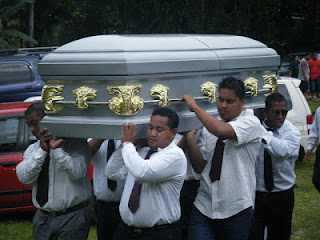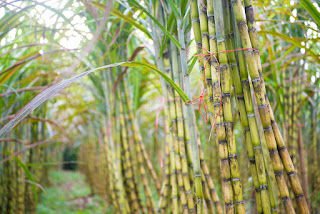Funeral in Pohnpei
One good example of Pohnpeian culture is funeral or "mehla" in our language. When a person dies, the family has a lot of responsibility to do. The family with some members of the community will get together to set up their place before the big crowd comes in. They will clean their place, set up the cooking place, etc. In the meantime, somebody representing the immediate family will go to the radio station and put up an announcement of the deceased. Some men will go to the king or "nahnmwarki" for invitation or "luk". This invitation goes to the nahnmwarki of the place the funeral will be held at. For example, if the funeral will be held at Madolenihmw municipality, the invitation will be given to the nahnmwarki of Madolenihmw.
When the nahnmwarki gets there,the men would present the sakau or cava plant and cut the branches off and get the roots ready for bounding. The master of ceremony would announce to the sakau makers to start bounding the sakau. When the sakau is ready, the first cup goes to the nahnmwarki. The second cup goes to the Nahnken or the second high ranking man in the nahs or the gathering house, the third cup or goes to the wife of the nahmwarki. And the last cup, which is the fourth one goes back to the nahnmwarki. After the nahnmwarki drinks the fourth cup ,the cup can be passed to everyone else in the nahs. The "umw" or the Pohnpeian local oven will be prepared. In the meantime, speeches will be given by the people. Some speeches will be about the clan of the deceased, how they are related to the deceased, and more.
After the speeches, the master of ceremony will call out to the ladies to pass foods they prepared for everyone. After everyone has been served lunch, the master of ceremony will call out to the men to spread the rocks of the "umw" to put the sluttered pigs, breadfruits, yams, and other local foods that will go with the plenty pigs that are killed during the day. After that, they will cover up the stone oven with banana leaves and the people will start bringing in the all the sakau in the nahs and the biggest sakau will be the last to be brought in and they will pile them up. One man will have to represent the family and give a speech about thanking everybody for coming to their funeral, apologizing if their work is not very satisfactory and announce the activities of the next day. After that, they will divide all the sakau for all the traditional leaders, relatives,and friends. The biggest sakau of the day will be distributed on all the bounding stones in the nahs. The master of ceremony will directed the men to start bounding the sakau. When the sakau is ready, he will call out for first cup and the the second cup, which will be given to the nahnmwarki and nahnken like the way they did when the nahnmwarki gets to the funeral site. After the fourth cup, some men will open up the stone oven and they will be bringing in the cooked pigs,yams, breadfruits or other local foods that were put in the stone oven for division. At the same time the family will take the coffin for burial.
The coffin is usually in the main house for people to come and weep and say their last words by prayers and songs, and by donating some money. Before burial, a priest or a pastor will say a prayer. After the prayer, all the ladies and children will cry. That is when some men will come in the house and take the coffin to the burial side. On their way to the burial side, people will be singing and crying. When they reach the burial side, the priests or pastor will complete the prayer. When the prayer is done, soil will be thrown on the coffin and the men will start burying the coffin. After the burial, the high ranking people will take their share of foods and go home, while some people will stay at the nahs to drink sakau.



Comments
Post a Comment